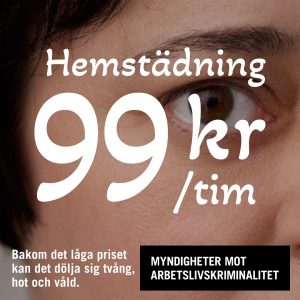Social dumping is not a clearly defined term. Out of the Nordic
countries, Denmark and Norway use it the most, while in Finland they
talk about ‘the grey economy’. In Sweden social dumping is a term which
is hardly used at all in public speech, according to Kerstin Ahlberg,
one of the authors of a new Nordic pilot study about how social dumping
is being fought in the Nordic region.
She has been writing about Sweden and Finland, while Line Eldring
from the Norwegian research foundation Fafo has been the project’s
leader and has written about Norway. Klaus Pedersen from the Danish
Employment Relations Research Centre, FAOS, has written about
Denmark.
Despite all the talk about the Nordic model, with its three-partite
cooperation, social safety nets and high degree of organisation, the
Nordic countries‘ ways of dealing with the problem of social dumping
vary a lot.
“Norway is an example of the changes that are taking place. From
being a country which had no system for universal applicability of
collective agreements, which is commonplace in Finland and Iceland, it
has now become more common – even though so far it has only happen in
four trades,” says Line Eldring.
The Norwegian government has defined social dumping as the act of
offering foreign workers wages and other conditions which are
unacceptably low compared to what Norwegian workers normally get, or
when other conditions like working hours, living quarters and working
environments don’t live up to existing rules or the expected
standard.
Denmark and Sweden stand apart not only in a Nordic comparison –
they are different from the rest of the EU because they have neither
minimum wages or any way of making collective agreements universally
applicable, so that they include hired or posted labour.
In Sweden and Denmark the social partners agree that they should
carry the full responsibility for wage moderation. There is great
reluctance to state involvement, despite the fact that it is becoming
increasingly difficult to safeguard wages and other hiring
conditions:
“The calls of isolated voices for Sweden to introduce some kind of
universally applicable collective agreements or legally binding minimum
wages are falling on deaf ears,” Kerstin Ahlberg writes about the
situation in Sweden.
“It is my impression that both the trade unions and employers in
Denmark are more interested in looking at the Norwegian experience than
what people in Sweden are. But they consider introducing universally
applicable agreements to be a step back,” says Line Eldring.
One explanation to the differences between the Nordic countries’
politics on social dumping could be the considerable differences
between them in the degree of organisation and in how dominating
collective agreements are.
| Country | Degree of organisation | Degree of collective agreement cover |
|---|---|---|
| Denmark | 68 | 80 |
| Finland | 69 | 90 |
| Iceland | 85 | 99 |
| Norway | 52 | 74 |
| Sweden | 71 | 91 |
2009 numbers, except for Iceland (2011).
Källa: Fafo
Norway has the lowest degree of organisation, while nearly 100
percent of Iceland’s labour force are covered by a collective
agreement.
There are also differences between the authorities who oversee the
labour market. In Finland it is the Occupational Safety and Health
Administration and in Norway the Labour Inspection Authority that are
responsible for controlling that companies follow wage agreements if
they are universally applicable. In Denmark and Sweden these
institution play no such role – wages are the parties’ responsibility,
nobody else’s.
“It is obvious that if authorities have a control function also when
it comes to wages, they get a more overarching grip of the issue of
social dumping,” Line Eldring writes in her conclusion.
There are, however, no simple answers to why Denmark and Sweden, who
both leave wage negotiations to the parties, still stand out when it
comes to how many people work in the Danish Working Environment
Authority and the Arbetarskyddsförvaltningen.
Denmark has 420 inspectors, but in Sweden – with twice the number of
citizens – there are only 286.
A common trait, however, is an increased interest in trades that use
a lot of foreign labour. This is reflected in the increase in money
granted to the Norwegian Labour Inspection Authority and Finland’s
Occupational Safety and Health Administration.





